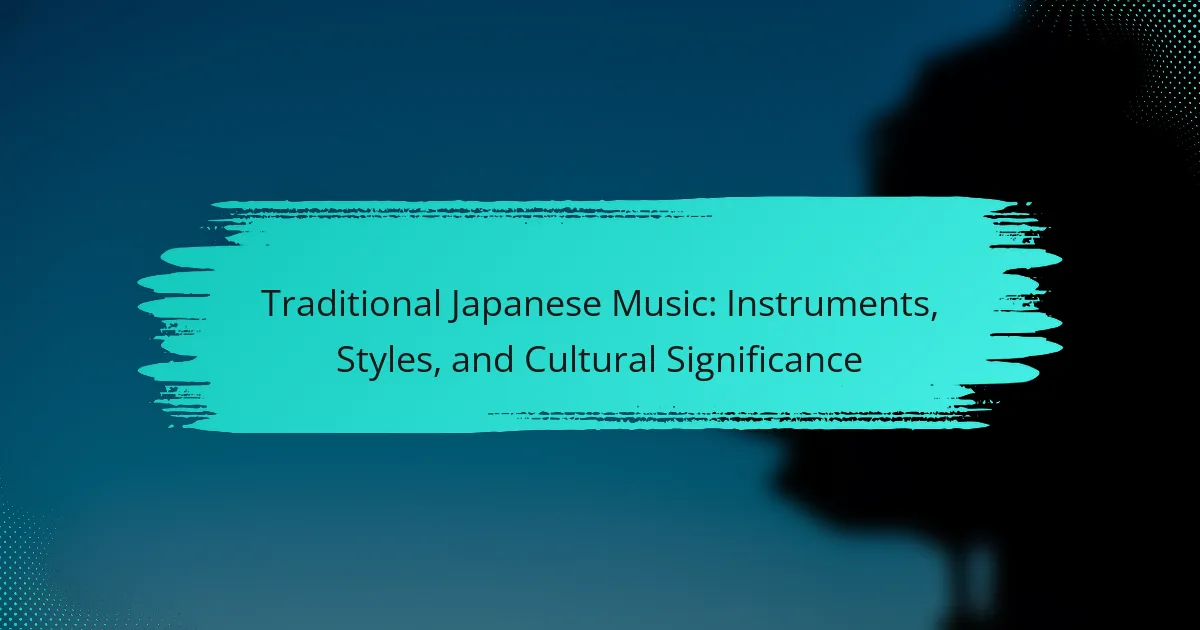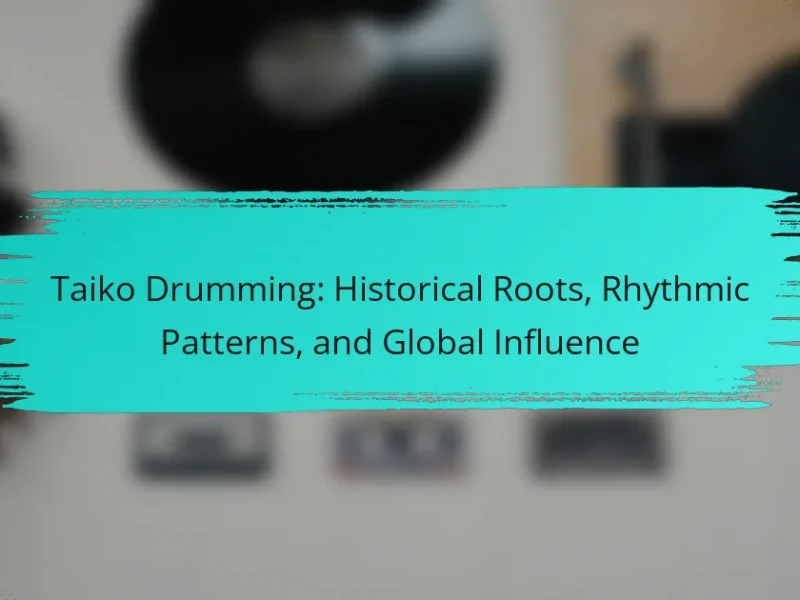Traditional Japanese music plays a crucial role in cultural expression and identity. It features key instruments like the shamisen, koto, shakuhachi, and taiko. The article explores various styles, such as Gagaku and Noh, while highlighting regional diversity and cultural significance. Additionally, it addresses the evolution of traditional music in modern contexts and the challenges it faces today.
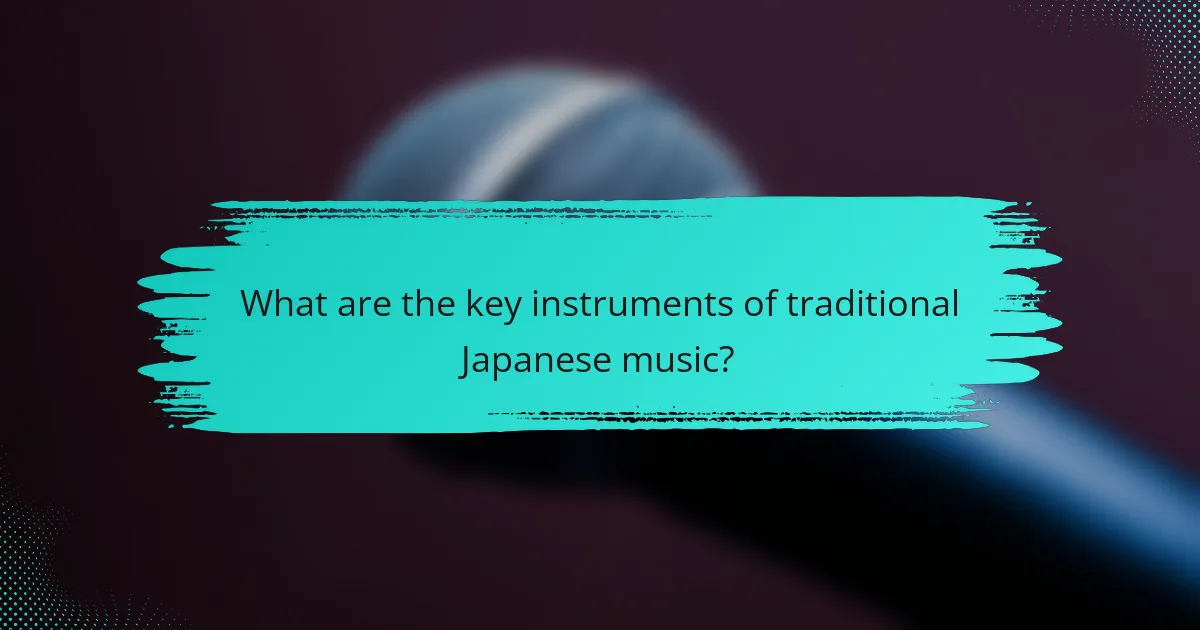
What are the key instruments of traditional Japanese music?
Traditional Japanese music features key instruments such as the shamisen, koto, shakuhachi, and taiko. The shamisen is a three-stringed instrument played with a plectrum, known for its expressive sound. The koto, a 13-string zither, offers a rich tonal range and is central to many performances. The shakuhachi, a bamboo flute, is renowned for its ability to convey deep emotion through its breathy tones. Lastly, the taiko, a traditional drum, provides powerful rhythms that drive the tempo of various musical styles. Each instrument contributes uniquely to the cultural significance and diversity of traditional Japanese music.
How do the shamisen and koto differ in sound and technique?
The shamisen and koto differ significantly in sound and technique. The shamisen produces a sharp, percussive tone due to its three strings and skin-covered body, while the koto has a softer, resonant sound from its thirteen strings and wooden construction.
In terms of technique, the shamisen is played with a plectrum, allowing for rapid strumming and rhythmic variations. The koto, on the other hand, is played by plucking strings with fingers or picks, enabling a wider range of melodic expression.
Both instruments are integral to traditional Japanese music, each contributing unique textures and styles to performances. The shamisen often accompanies storytelling, while the koto is frequently featured in solo compositions and ensemble settings.
What role does the shakuhachi play in Japanese musical traditions?
The shakuhachi plays a vital role in Japanese musical traditions as a traditional bamboo flute. It embodies spiritual and cultural significance, often associated with Zen Buddhism and meditation practices. The instrument’s unique sound reflects nature, enhancing its use in traditional Japanese music styles such as honkyoku, which emphasizes solo performance and improvisation. The shakuhachi’s versatility allows it to blend with various musical forms, enriching the overall cultural landscape of Japan. Its distinct timbre and playing techniques contribute to its status as a symbol of Japanese artistry and heritage.
Which percussion instruments are integral to traditional performances?
Traditional Japanese music features several integral percussion instruments, including the taiko, shime-daiko, and kakko. Taiko drums come in various sizes and are central to performances, providing rhythm and energy. Shime-daiko, a smaller drum, adds sharp, high-pitched sounds, while kakko, a double-headed drum, contributes a unique tonal quality. These instruments enhance the cultural significance of traditional performances, reflecting Japan’s rich musical heritage.

How do various styles of traditional Japanese music influence cultural expression?
Traditional Japanese music significantly influences cultural expression through its diverse styles and instruments. Each style, such as Gagaku and Noh, embodies unique cultural narratives and historical contexts. Gagaku, the oldest form, integrates courtly traditions, while Noh reflects philosophical themes. Instruments like the shamisen and koto contribute distinct sounds that evoke emotions tied to Japanese aesthetics. This musical heritage fosters a sense of identity and continuity, reinforcing community bonds and artistic expression.
What are the characteristics of Gagaku and its historical significance?
Gagaku is characterized by its slow, stately rhythms and unique instrumentation, reflecting its ancient origins. Historically, it served as the ceremonial music of the Japanese imperial court, emphasizing cultural continuity and spiritual significance. Gagaku integrates various musical styles, including vocal and instrumental forms, showcasing a rich tapestry of cultural influences, particularly from China and Korea. Its preservation over centuries highlights its role in maintaining Japan’s cultural heritage and identity.
How does Noh theater incorporate music into its performances?
Noh theater incorporates music through the use of traditional Japanese instruments, enhancing its dramatic narratives. Instruments like the flute, drums, and the biwa create a unique soundscape that complements the performance. The vocal style, known as “Noh singing,” is characterized by its distinct melodies and rhythms, which convey emotions and themes. This integration of music is essential, as it elevates the storytelling, providing cultural depth and resonance.
What distinguishes Min’yo folk music from other styles?
Min’yo folk music is distinguished by its regional variations, community-based performance, and use of traditional instruments. Unlike other Japanese music styles, Min’yo often reflects local culture and history. The music typically features a simple, repetitive structure and is performed in a participatory manner, encouraging audience involvement. Unique attributes include the use of specific regional dialects and styles, such as the distinct sounds of the shamisen or the folk songs of different prefectures. This folk genre plays a significant role in preserving cultural identity across Japan.
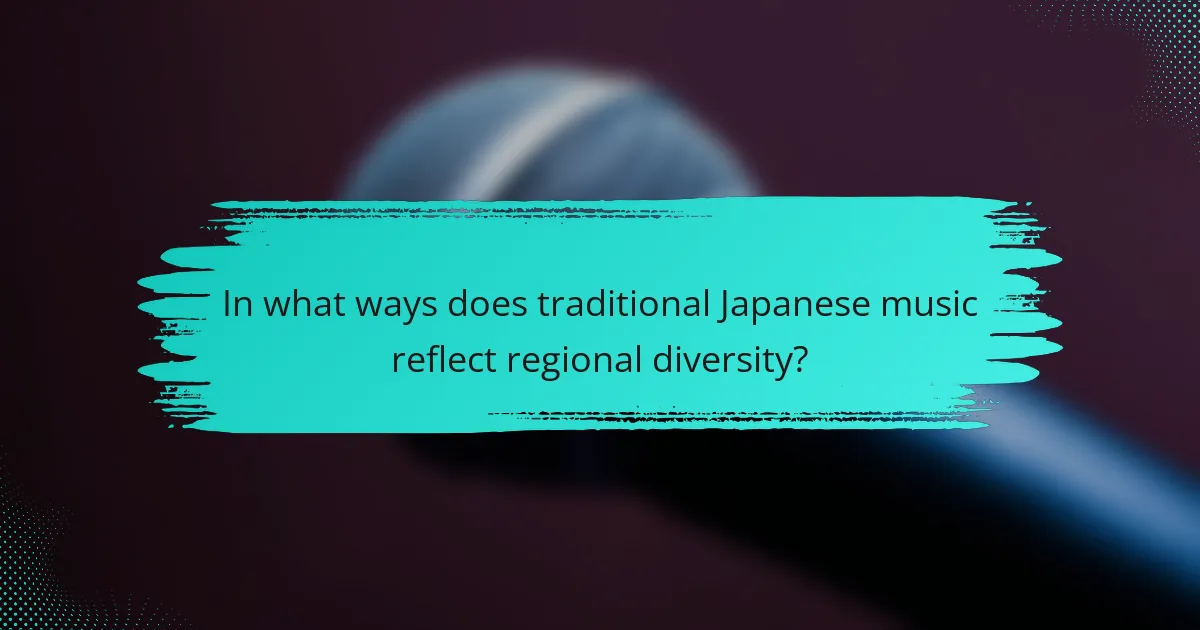
In what ways does traditional Japanese music reflect regional diversity?
Traditional Japanese music reflects regional diversity through distinct instruments, styles, and cultural contexts. Each region boasts unique musical traditions shaped by local history and environment.
For instance, the use of the shamisen is prevalent in the Kansai region, while the northern regions favor the biwa. Folk songs, such as those from Okinawa, showcase different scales and rhythms, emphasizing the islands’ cultural influences.
Additionally, regional festivals often feature unique musical performances that highlight local customs and traditions. The interplay of these elements creates a rich tapestry of sound that varies significantly across Japan.
This diversity not only enriches the musical landscape but also preserves the cultural heritage of each region, making traditional Japanese music a vital part of Japan’s identity.
Which regional styles are most prominent across Japan?
Traditional Japanese music features several prominent regional styles, including Gagaku, Noh, and Min’yō. Gagaku, the oldest form, originates from the imperial court and features elaborate instrumentation. Noh combines music, drama, and dance, emphasizing minimalism and poetic expression. Min’yō represents folk music, varying significantly across regions, reflecting local culture and traditions. Each style showcases unique instruments and performance techniques, contributing to Japan’s rich musical heritage.
How do local festivals influence the performance of traditional music?
Local festivals significantly enhance the performance of traditional Japanese music by providing a vibrant platform for cultural expression. These events foster community engagement, allowing musicians to showcase their skills and preserve musical heritage. Festivals often feature unique instruments like the shamisen and taiko, emphasizing their cultural significance. Additionally, the atmosphere of celebration encourages participation from diverse audiences, ensuring the music remains relevant and appreciated. As a result, traditional music evolves through interaction while maintaining its roots in Japanese culture.
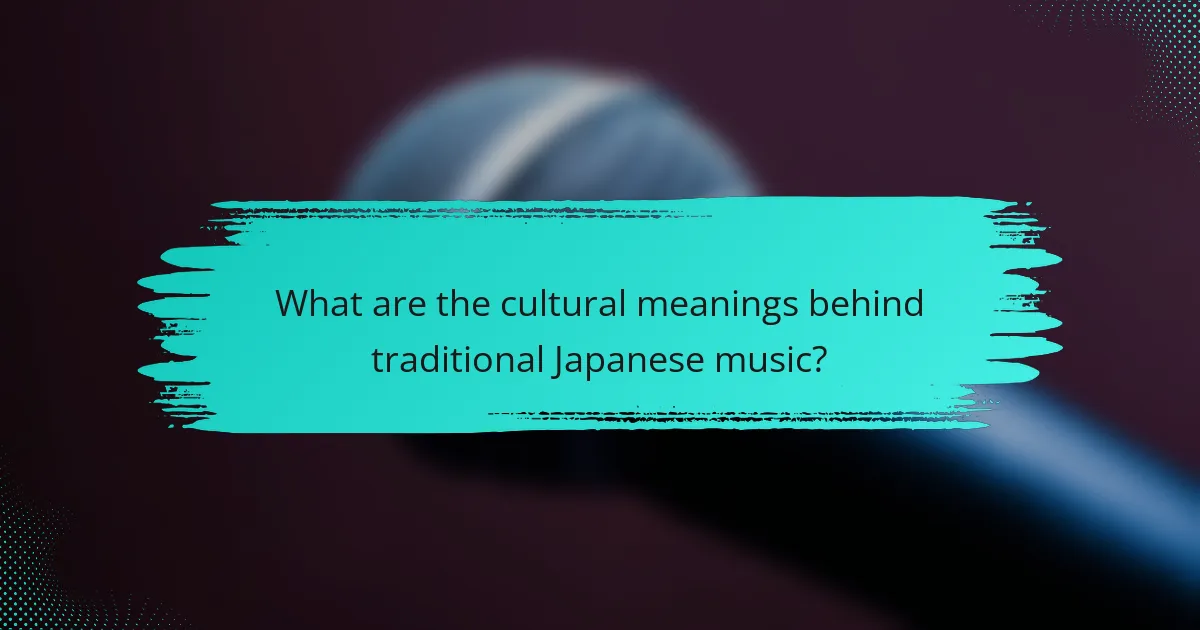
What are the cultural meanings behind traditional Japanese music?
Traditional Japanese music embodies deep cultural meanings, reflecting history, spirituality, and social values. It serves as a medium for storytelling and ritual, often linked to festivals and ceremonies. Instruments like the shamisen and koto symbolize harmony with nature, while styles such as Noh and Kabuki convey complex emotions and narratives. The music fosters community identity and continuity, preserving traditions across generations. Moreover, unique attributes like the use of scales and improvisation highlight Japan’s artistic diversity, making traditional music a vital cultural expression.
How does music play a role in Japanese spirituality and rituals?
Music plays a crucial role in Japanese spirituality and rituals by enhancing the emotional and spiritual experiences. Traditional Japanese music, such as gagaku and shōmyō, is integral to ceremonies and festivals, reflecting cultural values and beliefs. Instruments like the shamisen and koto create soundscapes that evoke a sense of connection to the divine. These musical forms often accompany rituals, reinforcing their significance and fostering communal bonds. The unique attributes of traditional music, including its use in specific spiritual contexts, highlight its importance in Japanese cultural identity.
What is the significance of music in Japanese seasonal celebrations?
Music plays a vital role in Japanese seasonal celebrations, enhancing cultural traditions and community bonds. Traditional Japanese music, featuring instruments like the shamisen and koto, accompanies festivals and rituals, reflecting seasonal themes. For instance, during Hanami, cherry blossom viewing, music creates a festive atmosphere, celebrating nature’s beauty. Additionally, unique styles such as Gagaku, the ancient court music, add historical depth to celebrations, preserving cultural heritage. Seasonal celebrations in Japan exemplify how music enriches communal experiences and fosters a sense of identity.
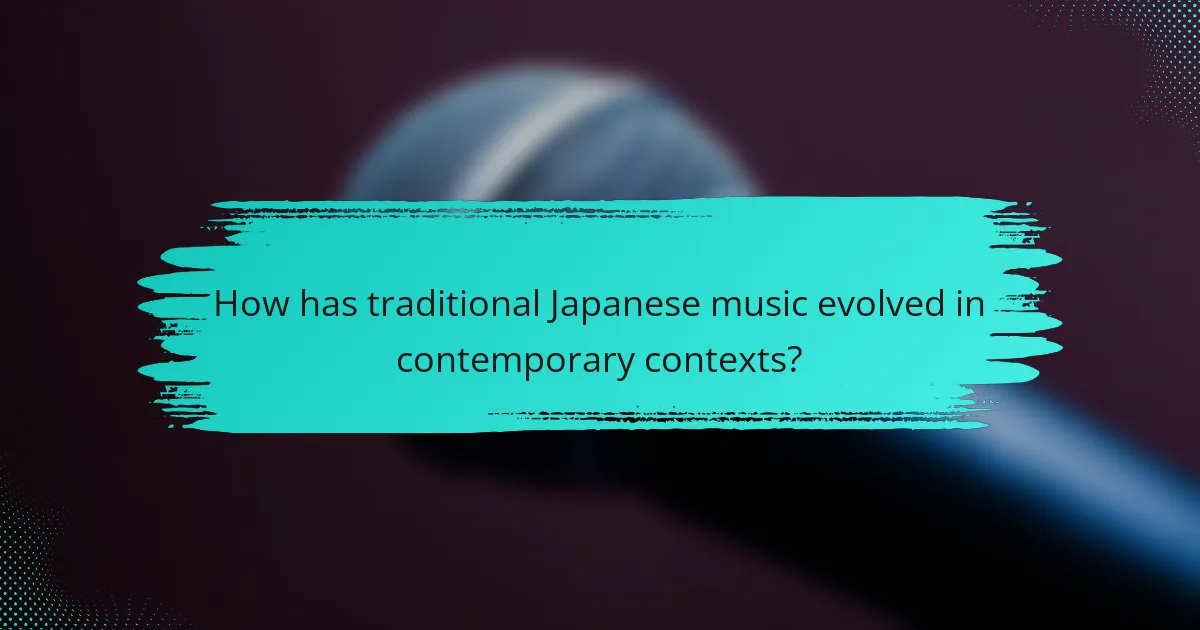
How has traditional Japanese music evolved in contemporary contexts?
Traditional Japanese music has evolved by integrating modern influences while preserving its core elements. Contemporary artists blend traditional instruments, such as the shamisen and koto, with modern genres like pop and jazz. This fusion creates a unique sound that appeals to younger audiences and expands cultural significance. Additionally, global platforms have increased accessibility, allowing traditional music to reach diverse listeners, fostering appreciation and innovation. The unique attribute of traditional Japanese music lies in its ability to adapt while maintaining deep cultural roots.
What modern interpretations of traditional music are gaining popularity?
Modern interpretations of traditional Japanese music are increasingly popular, blending traditional instruments with contemporary genres. Artists are incorporating elements like jazz, electronic, and pop into their work. This fusion creates a unique sound that attracts younger audiences while preserving cultural significance. For example, collaborations between traditional shamisen players and modern musicians showcase this innovative approach. The use of technology, such as digital platforms for distribution, enhances accessibility and engagement with traditional music forms.
How do collaborations between traditional and contemporary artists shape the genre?
Collaborations between traditional and contemporary artists enrich the genre by blending techniques and cultural narratives. These partnerships often result in innovative compositions that honor historical practices while incorporating modern influences. For instance, traditional instruments like the shamisen or koto may be combined with electronic music elements, creating unique soundscapes. This fusion not only preserves cultural heritage but also attracts new audiences, ensuring the evolution of traditional Japanese music. As a result, these collaborations enhance the genre’s relevance in today’s diverse musical landscape.
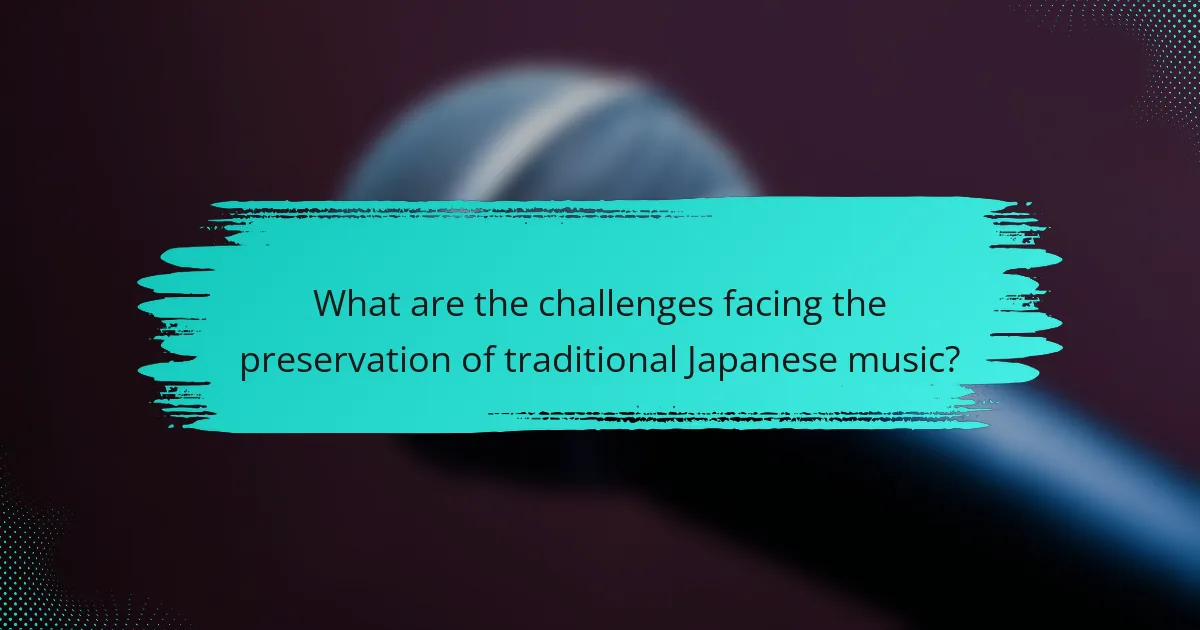
What are the challenges facing the preservation of traditional Japanese music?
Traditional Japanese music faces challenges such as modernization, declining interest, and loss of traditional skills. The influence of Western music has shifted cultural preferences, making it harder for traditional forms to thrive. Additionally, fewer young musicians are trained in traditional instruments, risking the cultural heritage. Preservation efforts are crucial to maintain the unique attributes of this music, including its distinctive instruments and styles.
How do educational institutions contribute to the sustainability of traditional music?
Educational institutions play a vital role in preserving traditional Japanese music through education, performance, and research. They offer specialized programs that teach instruments like the shamisen and koto, ensuring that skills are passed to new generations.
Moreover, institutions host workshops and concerts that promote cultural appreciation, providing platforms for students and local artists. Collaborations with cultural organizations further enhance outreach, engaging communities in the significance of traditional music.
Research initiatives contribute to documenting and analyzing traditional music, fostering a deeper understanding of its historical context and evolution. This academic inquiry supports the preservation of unique attributes, such as regional styles and techniques, vital for maintaining the richness of traditional Japanese music.
Overall, educational institutions are central to sustaining traditional music, ensuring its relevance and vitality in contemporary society.
What role does technology play in the dissemination of traditional music?
Technology significantly enhances the dissemination of traditional Japanese music by facilitating access and preservation. Digital platforms allow wider audiences to experience various instruments and styles, such as the shamisen and koto. Streaming services and social media promote cultural exchange, making traditional music more accessible globally. Additionally, technology aids in archiving performances, ensuring cultural significance is maintained for future generations. As a result, traditional Japanese music thrives in contemporary contexts, attracting new listeners and preserving its rich heritage.
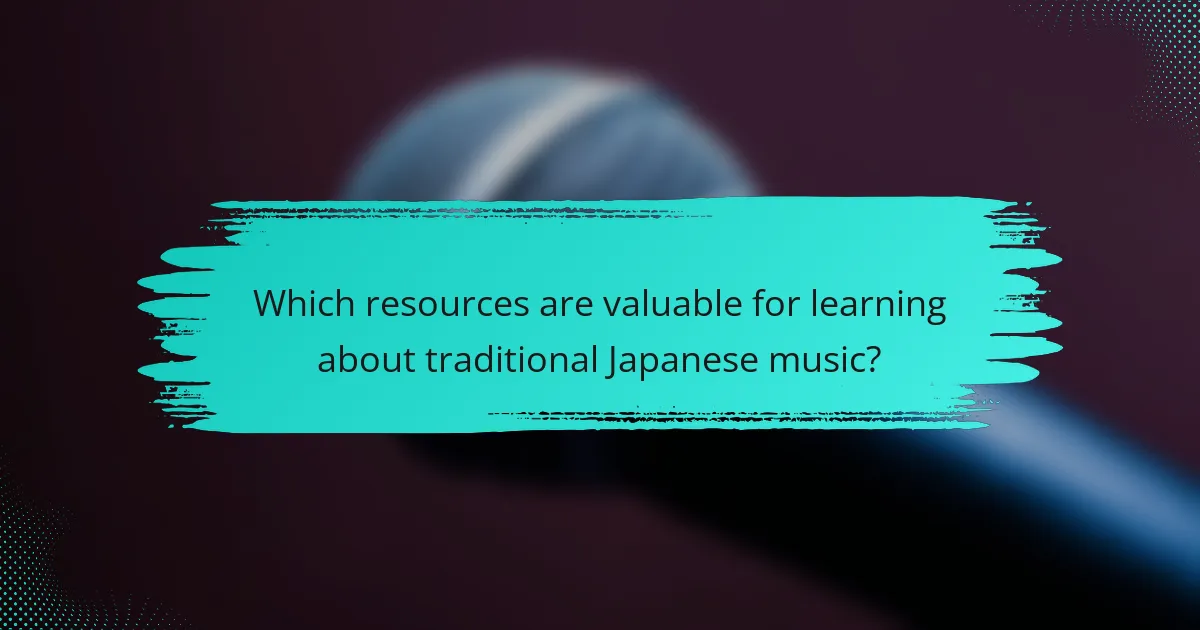
Which resources are valuable for learning about traditional Japanese music?
Valuable resources for learning about traditional Japanese music include books, online courses, and documentaries. Notable books like “The Music of Japan” by T. T. S. Wong provide insights into instruments and cultural significance. Online platforms such as Coursera offer courses on Japanese music history. Documentaries like “The Sound of Japan” showcase performances and interviews with musicians, enriching understanding of various styles. Additionally, visiting museums with music exhibits can provide firsthand experience of instruments and their cultural context.
What are the best practices for engaging with traditional music communities?
Engaging with traditional music communities involves respectful participation and active listening. Start by attending local performances to appreciate the art form. Collaborate with musicians to learn about their instruments and styles. Share your experiences on social media to foster connections. Support events that promote traditional music to strengthen community ties. Lastly, encourage intergenerational dialogue to preserve cultural significance.
How can one effectively participate in traditional Japanese music events or workshops?
To effectively participate in traditional Japanese music events or workshops, engage actively and respect cultural practices. Familiarize yourself with instruments like the shamisen and koto, and learn basic techniques. Attend local events to connect with musicians and communities.
Consider taking classes or online courses to understand different styles, such as gagaku or folk music. Networking with fellow enthusiasts can enhance your experience and provide insights into the cultural significance of the music.
